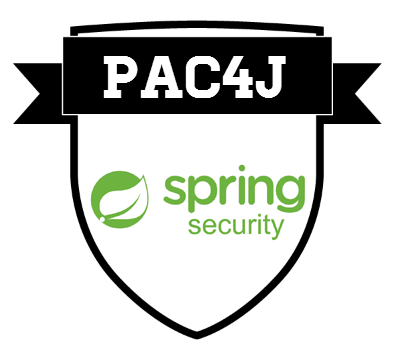If you already use the Spring Security security library, you need to use the spring-security-pac4j security extension which makes multi-protocol (CAS, OAuth, SAML...) support really easy and consistent. It successfully replaces the spring-security-cas, spring-security-oauth, spring-security-saml2-core, spring-security-openid and Spring Social libraries and also adds missing protocols.
If you are looking for a full security library, you can directly use a pac4j implementation for your environment: spring-webmvc-pac4j for Spring MVC / Boot, j2e-pac4j for J2E, play-pac4j for Play framework v2... See all the frameworks and tools supported by pac4j.
spring-security-pac4 supports many authentication mechanisms, called clients:
- indirect / stateful clients are for UI when the user authenticates once at an external provider (like Facebook, a CAS server...) or via a local form (or basic auth popup).
See the authentication flows.
| The authentication mechanism you want | The pac4j-* submodule(s) you must use |
|---|---|
| OAuth (1.0 & 2.0): Facebook, Twitter, Google, Yahoo, LinkedIn, Github... | pac4j-oauth |
| CAS (1.0, 2.0, 3.0, SAML, logout, proxy) | pac4j-cas |
| SAML (2.0) | pac4j-saml |
| OpenID Connect (1.0) | pac4j-oidc |
| HTTP (form, basic auth) + LDAP or Relational DB or MongoDB or Stormpath or CAS REST API |
pac4j-http+ pac4j-ldapor pac4j-sqlor pac4j-mongoor pac4j-stormpathor pac4j-cas |
| Google App Engine UserService | pac4j-gae |
| OpenID | pac4j-openid |
First, you need to add a dependency on this library as well as on the appropriate pac4j submodules. Then, you must define the clients for authentication.
Define the ClientAuthenticationFilter and ClientAuthenticationProvider to finish authentication processes.
Use the ClientAuthenticationEntryPoint entry point (using the clientName property for authentication) to start login at identity providers for the secured urls of your web application.
Just follow these easy steps:
You need to add a dependency on spring-security-pac4j (groupId: org.pac4j, version: 1.4.0) as well as on the appropriate pac4j submodules (groupId: org.pac4j, version: 1.8.1): the pac4j-oauth dependency for OAuth support, the pac4j-cas dependency for CAS support, the pac4j-ldap module for LDAP authentication, ...
All released artifacts are available in the Maven central repository.
Each authentication mechanism (Facebook, Twitter, a CAS server...) is defined by a client (implementing the org.pac4j.core.client.Client interface). All clients must be gathered in a org.pac4j.core.client.Clients class.
You have to define all the clients in your Spring context XML file:
<bean id="facebookClient" class="org.pac4j.oauth.client.FacebookClient">
<property name="key" value="fbKey" />
<property name="secret" value="fbSecret" />
</bean>
<bean id="twitterClient" class="org.pac4j.oauth.client.TwitterClient">
<property name="key" value="twKey" />
<property name="secret" value="twSecret" />
</bean>
<bean id="usernamePasswordAuthenticator" class="org.pac4j.http.credentials.authenticator.test.SimpleTestUsernamePasswordAuthenticator" />
<bean id="formClient" class="org.pac4j.http.client.indirect.FormClient">
<property name="loginUrl" value="http://localhost:8080/loginForm.jsp" />
<property name="authenticator" ref="usernamePasswordAuthenticator" />
</bean>
<bean id="casClient" class="org.pac4j.cas.client.CasClient">
<property name="casLoginUrl" value="http://mycasserverurl" />
</bean>
<bean id="clients" class="org.pac4j.core.client.Clients">
<property name="callbackUrl" value="http://localhost:8080/callback" />
<property name="clients">
<list>
<ref bean="facebookClient" />
<ref bean="twitterClient" />
<ref bean="formClient" />
<ref bean="casClient" />
</list>
</property>
</bean>
"http://localhost:8080/callback" is the url of the callback endpoint (see below).
Indirect clients rely on external identity providers (like Facebook) and thus require to define a callback endpoint in the application where the user will be redirected after login at the identity provider.
Thus, you need to define the appropriate ClientAuthenticationFilter in your Spring context XML file:
<bean id="clientFilter" class="org.pac4j.springframework.security.web.ClientAuthenticationFilter">
<property name="clients" ref="clients" />
<property name="authenticationManager" ref="authenticationManager" />
</bean>
<bean id="clientProvider" class="org.pac4j.springframework.security.authentication.ClientAuthenticationProvider">
<property name="clients" ref="clients" />
</bean>
Notice you have one additional element for Spring Security:
- the provider:
ClientAuthenticationProviderwith uses by default theCopyRolesUserDetailsServiceuser details service to set the roles from the ones in the user profile (granted by anyAuthorizationGeneratorattached to the client used).
You can protect an url and require the user to be authenticated by a client by using the appropriate security configuration with entry points. For example :
<security:http pattern="/facebook/**" entry-point-ref="facebookEntryPoint">
<security:intercept-url pattern="/facebook/**" access="isAuthenticated()" />
</security:http>
<security:http pattern="/twitter/**" entry-point-ref="twitterEntryPoint">
<security:intercept-url pattern="/twitter/**" access="isAuthenticated()" />
</security:http>
...
<security:http pattern="/**" entry-point-ref="casEntryPoint">
<security:csrf disabled="true"/>
<security:headers disabled="true" />
<security:custom-filter after="CAS_FILTER" ref="clientFilter" />
<security:intercept-url pattern="/cas/**" access="isAuthenticated()" />
<security:intercept-url pattern="/**" access="permitAll()" />
<security:logout logout-success-url="/" />
</security:http>
...
<bean id="facebookEntryPoint" class="org.pac4j.springframework.security.web.ClientAuthenticationEntryPoint">
<property name="client" ref="facebookClient" />
</bean>
<bean id="twitterEntryPoint" class="org.pac4j.springframework.security.web.ClientAuthenticationEntryPoint">
<property name="client" ref="twitterClient" />
</bean>
...
<bean id="casEntryPoint" class="org.pac4j.springframework.security.web.ClientAuthenticationEntryPoint">
<property name="client" ref="casClient" />
</bean>
For SAML support which requires Javascript POST (POST binding), notice the <security:headers disabled="true" />.
You can also explicitly compute a redirection url to a provider by using the getRedirectAction method of the client, in order to create an explicit link for login. For example with Facebook:
<%
WebContext context = new J2EContext(request, response);
Clients clients = (Clients) application.getAttribute("clients");
FacebookClient fbClient = (FacebookClient) clients.findClient(context, "FacebookClient");
String redirectionUrl = fbClient.getRedirectAction(context, false).getLocation();
%>
After a successful authentication, you can get the identity of the user using the regular SecurityContextHolder class :
ClientAuthenticationToken token = (ClientAuthenticationToken) SecurityContextHolder.getContext().getAuthentication();
// user profile
UserProfile userProfile = token.getUserProfile();
CommonProfile commonProfile = (CommonProfile) userProfile;
The retrieved profile is at least a CommonProfile, from which you can retrieve the most common properties that all profiles share. But you can also cast the user profile to the appropriate profile according to the provider used for authentication. For example, after a Facebook authentication:
FacebookProfile facebookProfile = (FacebookProfile) commonProfile;
For logout, like for any other Spring Security webapp, use the default logout filter (in your Spring context XML file):
<security:logout logout-success-url="/" />
The demo webapp: spring-security-pac4j-demo is available for tests and implement many authentication mechanisms: Facebook, Twitter, form, basic auth, CAS, SAML...
See the release notes. Learn more by browsing the spring-security-pac4j Javadoc and the pac4j Javadoc.
If you have any question, please use the following mailing lists:
The version 1.4.1-SNAPSHOT is under development.
Maven artifacts are built via Travis: 
<repositories>
<repository>
<id>sonatype-nexus-snapshots</id>
<name>Sonatype Nexus Snapshots</name>
<url>https://oss.sonatype.org/content/repositories/snapshots</url>
<releases>
<enabled>false</enabled>
</releases>
<snapshots>
<enabled>true</enabled>
</snapshots>
</repository>
</repositories>
